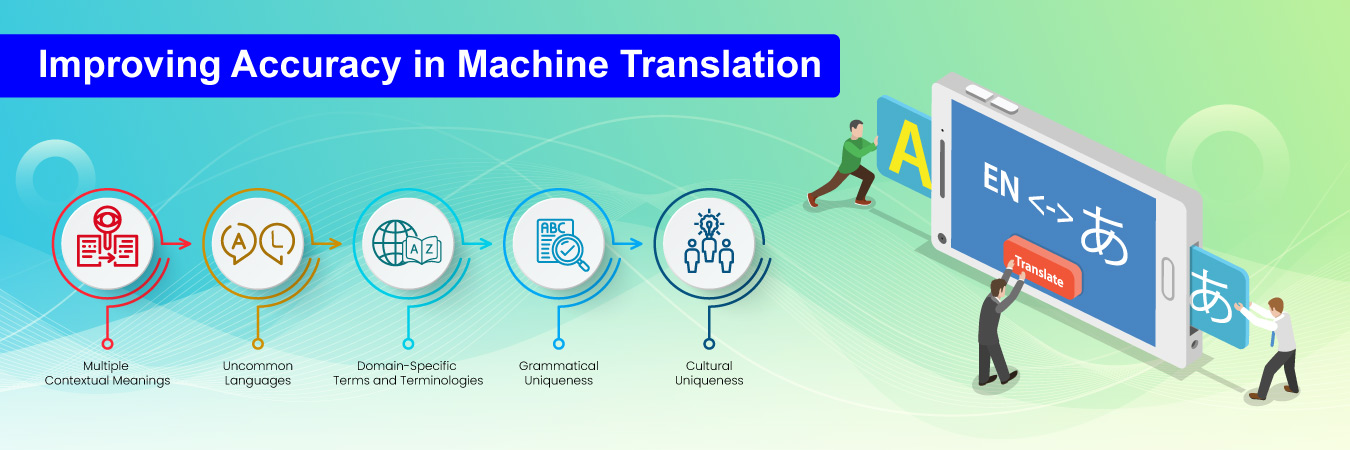
Improving Accuracy in Machine Translation: Techniques and Challenges
Machine translations expedite the pace of translation and help translators deliver projects more quickly. However, machine translation is an evolving sphere. Hence, it isn’t perfect and can pose several challenges with which translators should deal effectively. Here are some challenges in machine translation and the potential solutions for them.
5 Common Challenges in Machine Translation and Their Solutions
Machine translation runs on a technology that could have flaws and limitations. Let’s look at five common challenges in machine translation and their techniques.
1. Multiple Contextual Meanings
Many words in various languages can have multiple meanings, connotations, implications, etc., depending on the context. While that signifies linguistic versatility, it poses a challenge for translators who have to deal with it.
Expecting a machine translation solution know all of it could be unrealistic. It is because machine translation is an evolving technology and might not have everything fed into it every moment. Technologies today learn with every interaction. Hence, companies designing such solutions should consider such technical linguistic complications.
A potential solution to such a problem would be using contextual understanding models like transformer-based architectures to capture a particular context and disambiguate meanings. It can help make the translation clearer and more accurate without requiring the translator to worry about ambiguity. A comprehensive manual quality check will still be required, as one cannot fully rely on machine translation in such cases.
2. Uncommon Languages
Not every language is as commonly spoken. For instance, many languages across the African continent have fewer speakers and do not have as much literature available, to which the machine translation tool can refer. In such cases, the translation outcome could be inaccurate or half-baked, thus defeating the purpose of the translation.
A potential solution to this challenge would employ transfer learning techniques, wherein knowledge you should transfer learning from high-resource languages to low-resource ones. Furthermore, companies must constantly strive to gather and augment the data for such languages to ensure the translation tool continues learning.
3. Domain-Specific Terms and Terminologies
Another significant challenge associated with machine translation is contextual or domain-specific translations. Many domains have their specific and unique language, way of saying things, constructing sentences, and terms and terminologies that may not necessarily be known to the automated translation tool.
A lack of an understanding of technical terms and language can result in inaccuracies and even worse lead to undesirable actions. In such cases, the tool would translate the term as it is, based on how it is trained and make the outcome lose its meaning. An effective solution to this problem is indulging domain adaptation techniques that involve aligning models with domain-specific data to enhance translation accuracy for a specific domain.
4. Grammatical Uniqueness
Every language is unique and so are its grammar rules and syntax. Often, these variations make it challenging for the machine translation tool to translate the text. The resultant translated sentence not only looks grammatically incorrect but may appear senseless.
One cannot complain about grammatical diversity. It will be there and has to be dealt with appropriately. Thus, translation companies must train machine learning tools on syntax and grammar rules like sequence-to-sequence models with attention mechanisms. They can help in understanding and delivering grammatically correct translations.
5. Cultural Uniqueness
Languages evolve with time. Hence, a particular language wouldn’t be what it was a few decades or centuries ago. It would have a lot of unique idioms, colloquialisms, or cultural elements a machine translator wouldn’t know. For instance, many adages are specific to English. One cannot translate them into another language. Even if they attempt to do so, the reader would be clueless about the message conveyed.
In such cases, the machine translation model should undergo continuous model training on versatile datasets encompassing various linguistic expressions and cultural contexts to deal with such challenges. Translation isn’t merely about converting text from one language to another. It also conveys the required message appropriately, without diluting its meaning, yet while giving it an appropriate local flavor.
Are you looking for accurate translations in multiple languages and language pairs? Partner with Fidel. We are global localization company with expertise in over 100 Indian and foreign languages. Our experts leverage a blend of automated and manual translations to ensure linguistically, contextually, culturally, and technically accurate translations. Please email us at sales@fidelsoftech.com to explore more about our translation and localization support.
Ref. No – FB01241082
Related Blogs
What is the Role of SAP Localization?
SAP, which stands for System Applications and Products is an ERP software solution, helps companies manage operations and customer…
Unlocking Growth: Globalization Marketing Advantages
At some point in time, every organization looks to expand its horizon and venture into markets never explored before. However, every market is...
Advantages and Disadvantages of Internationalization
These days, most businesses that intend to go global know they will have to align their offerings and communication to suit the target audience’s...



